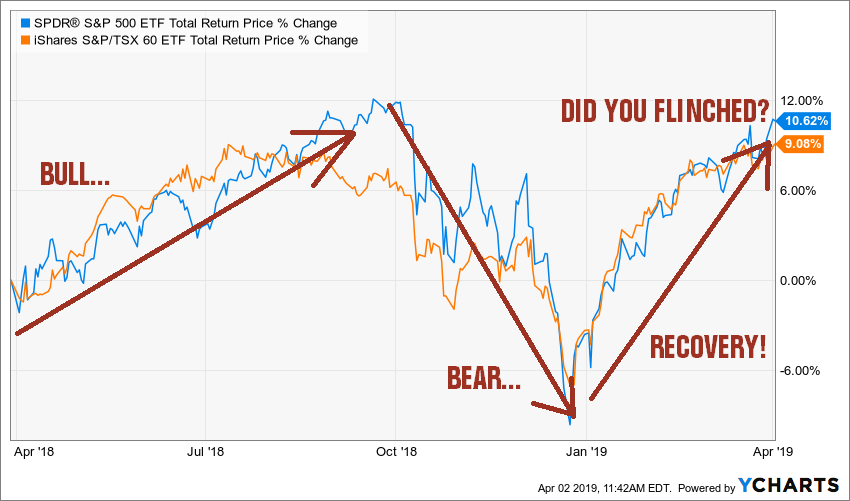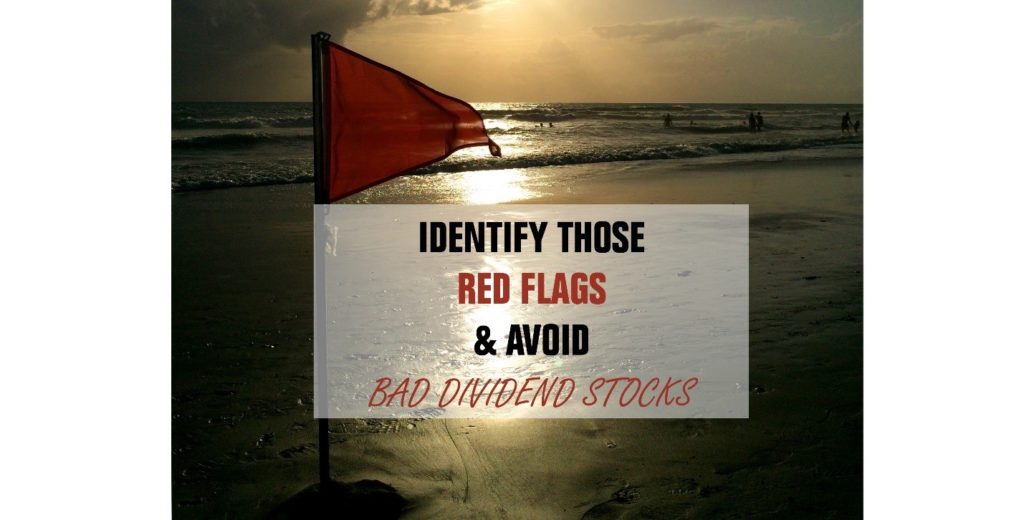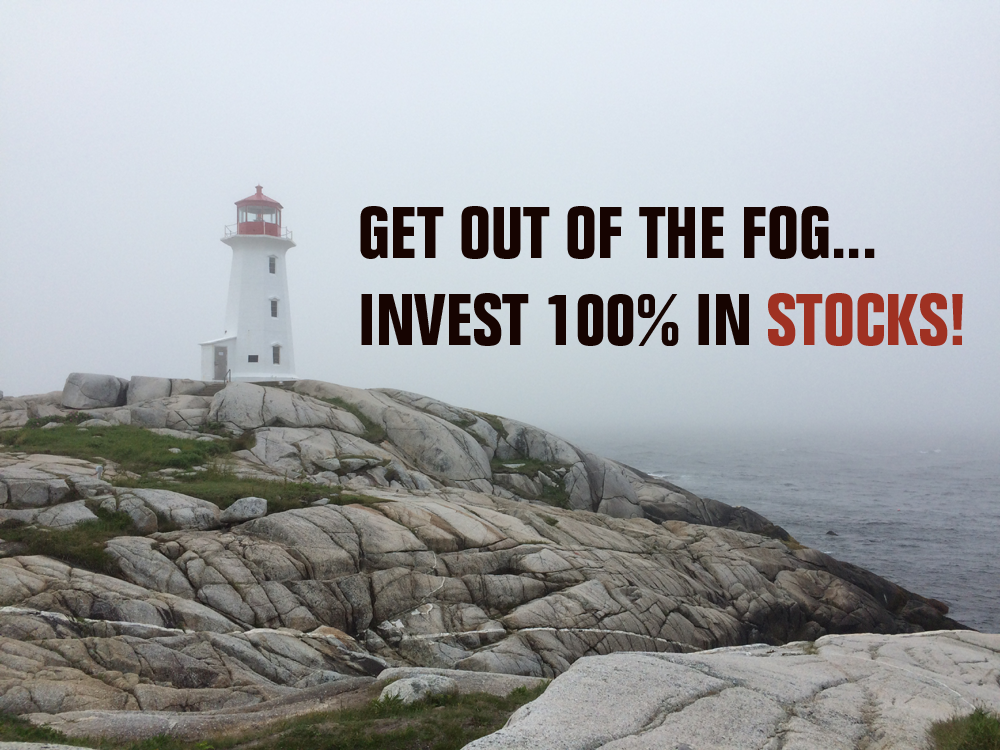
I’ll be honest, I’ve never been a fan of winter. Since I spent almost an entire year in Central America and totally skipped the snow during that trip, my skin can’t cope with our cold winter anymore. This is why I’m so happy to see April coming with more sunny and warmer days! I’m back at my running schedule lately and I can’t get enough. After all, I have to get ready for my “beach body”. Winter has this “bear hibernation” effect on my body where a few more pounds are being accumulated. Since I work in front of my computer all day long, I must find ways to exercise and keep-up a good shape. As life goes on, we often forget about our health. We get caught up with many things. Routine is our master and we just forget to revisit our status quo. I think taking care of my portfolio is like taking care of my body. It requires simple actions that are difficult to maintain over the long run.
Beach body… Beach money!
As we sometimes forget to get in good physical shape, we also tend to forget our financial shape. Before summer hits and you go on vacation, it’s time to make sure your portfolio is in good shape. If you are willing to go the extra mile to have a beach body, you might as well go for your beach money!

Did the past 12 months hurt your return?
The first question you must ask yourself is the following:
“How did I react in 2018? How did the recent drop affected my portfolio and my investing strategy?”
If you had a solid plan, you probably didn’t even flinch. You’re that guy/gal with that six-pack eating chicken breast (not fried) salad while others eat-up donuts and BBQ ribs. You have a meal plan, you have a training plan and you stick to the course. Even when you “let go” for a few parties and gourmet diners during the Holidays, your healthy routine will kick-back in and the impact on your body will be minimal.
This is exactly why I’m always fully invested in the market (read some comparisons with the “cash in hand approach” here, it will shock you). If have a solid investment plan, you probably didn’t even have the time to calculate your paper losses to recover your money in full. As you can see, both US and CDN markets followed a similar trend and almost fully recovered from their all-time peak of summer 2018.

Source: Ycharts
Even better, if you look at it on a one-year basis, the market is still doing better than April 2018. I’d say a lot better! I’ve been tracking my pension plan portfolio since September 2017 (the date started investing this account) and both my Cdn and US portfolios went through 2018 without bleeding:

(CDN on the left, US portfolio on the right, full portfolio here).
The reason why my portfolio did well is pretty simple; I invest according very strict guidelines. I have 7 investing rules I follow to manage my money. Those rules have been proven through academic researches done by smarter people than me. Interesting enough, most rules are quite linked to common sense. You don’t need to be a genius to be successful on the stock market. As I mentioned earlier, actions to make sure your portfolio stay fit are quite simple, but they are difficult to apply all the time. Here are a few actions you can take to make your portfolio in great shape again. I’ve kept the “personal fitness theme” and applied it to a “portfolio fitness guide”.
01 Avoid Junk Food

Many research studies have proven that if you want to lose weight, all you need to do is eat better. If you have a big Mac combo (regular fries and a Coke), you will likely hit over 1,000 calories. Do you know how much time one must run to burn that up? At my size, I need to run around 10Km in an hour. What’s easier to do in your daily routine? Add a 1 hour run or skip a Mickey D’s special meal?
It’s the same thing with your portfolio. You can add more money each month to make it grow, but it won’t matter if you invest all your money in General Electric (GE) and the likes. Pump as much money as you want in your portfolio, you will never get anywhere if you don’t invest wisely.
In order to do so, you must describe the kind of stocks you want to purchase. Companies in your portfolio must meet specific criterions. You must first be able to identify red flags telling you to stay away from some businesses. While I don’t over analyze what is happening between the U.S. and China and I don’t waste my time predicting the price of oil or gold, I do spend a lot of time watching companies in my portfolio and making sure they don’t show red flags. Those red flags that announce the company isn’t doing so well and that they might eventually cut their dividend.
02 Eat Well
Once you have identified the “bad food” in your diet, it’s time to replace it by some “good nutrients”. You want to select some “superfood” to help boost your portfolio return. As is the case with food, great companies don’t always have an immediate impact on your portfolio. I sometimes hear investors saying
“well, stock XYZ did poorly in the past 12 months, why did you buy it?”.
It would be similar to say:
“I’ve been eating well for 3 months and I haven’t lost 40 pounds yet, what’s the problem?”.
Remember, you invest for the long haul. Quick rich stock picking strategies only exist for those who sell you their “secret formula”. For others, there is nothing like a meticulous approach in selecting a handful of great companies, and then wait. I’ve based my investing strategy on dividend growth. This is one way, but not the only way, to achieve it. At the beginning of the year, I highlighted some key points of my strategy. Those factors were discussed as the market was seriously beaten down and they have proven to work very well in the past few years (even during the market correction). At that time, I wrote the following:
“I tend to have a simple and rational way of looking at the market. Whatever will happen in 2019 will happen- no matter what I think, no matter how I invest. There is no point in guessing that. How should I invest my money in 2019? The exact same way I did in 2018, 2017, 2016…2010. This article includes my guidelines to build a safe dividend portfolio in 2019… and beyond.”
You can read the full article here.
03 Train consistently

Setting up your “investing diet” is probably the most difficult part of the process. It is simple (who can’t make the difference between donuts and avocadoes?), but very difficult to apply everyday. Once you achieve this milestone, it’s then time to give a little more to your body. When you want to lose weight, the first item on your list is to eat better. Once you start losing weight, the second item on your list will be to get your body firmer and stronger. In other words, go for that six pack!
The best way to ensure your portfolio grows in the upcoming year is by investing consistently. Don’t keep cash aside and make sure you invest your money, so it works for you. As I mentioned; simple advice, difficult to apply. Many investors fear another market drop. This is why apocalyptical articles are so popular; it hurts more to lose money than it makes you happy to make some.
Back in November, I mentioned on my blog that “Today is always the right day to invest”. Then, I pulled out quotes like this one:
“At ValuEngine.com we show that 77.8% of all stocks are overvalued, 45.2% by 20% or more. All 16 sectors are overvalued; consumer staples by 17.6%, retail-wholesale by 26.4% and utilities by 9.8%.”
~ Forbes
Funny enough, this “valuation claim” was stated in September of… 2013!
I agree that if you invest today all your money and the market enters in full bearish mode tomorrow morning, you will hate me for a while (and hate the fact you didn’t do you due diligence prior to making any moves).
However, what are the odds it will happen in 2019?
What were the odds in 2018?
What were the odds in the past 5 years?
That’s the whole point. Your odds are that your money will grow enough to support the next market correction. If you want to feel better, you can always pull out stats of how many times in the market history we saw two drops of about 20% in the same 24 months (I don’t have the answer for that question, but I would surely like to have the answer!).
A great way to avoid this “analysis by paralysis” syndrome is to keep investing new money all the time. When you invest on a monthly basis, it hurts less to see it go down. In fact, you only have the impression that you are buying at discount!
04 No excuses ignoring rule #1 and #2

Do you know why most diets or training programs fail to make you fit for summer? It’s because you fail to follow them rigorously. We always have occasions to call for a mulligan, right? It’s the weekend, we had a hard day, it’s her birthday, it’s his departure dinner, it’s Easter (God I love chocolate!). But when you look at it, we take mulligans every single week. Similar results will happen to your portfolio if you are tempted to take mulligans such as…
This stock has lost 50% of its value, but it’s going to bounce back.
This company cut its dividend, but it’s to get more financial flexibility.
I read there’s a lot of money to be made with bitcoins.
Pot stocks can only go higher, it’s the new trend.
Each time you ignore your investing process, you are putting your money at risk. The problem is that you will most likely ignore your own rules more than once. I personally allow myself a 5 to 10% in “play money” within my portfolio. From time to time, I will go with riskier assets but I never put more than 10% of my portfolio at risk. Even then, I find 10% is a lot.
When I look at my current pension portfolio, I don’t have any stocks outside of my investing rules. Since the market is quite volatile and we are unsure if the market will drop or not, I make sure I won’t suffer unnecessary losses. Therefore, I invest solely in companies I’m comfortable holding on to for the next 5 to 10 years. Those are all dividend growth stocks showing a strong dividend triangle. You will notice that most of them are dividend achievers as well (10yr+ with consecutive dividend increases).
05 Get a plan, that’s how you progress

If you managed to get this far (and read the whole article!), you probably realize the only way you can achieve both having a healthy alimentation and training consistently is with a complete plan. My plan for my healthy alimentation is called “my wife” as she is incredibly good at cooking great stuff that is both delicious and nutritious. However, I take care of my training personally. I make sure I know what my week will look like before I start it.
A similar approach needs to be developed for your portfolio. How can you plan your retirement portfolio, so you don’t outlive your money- so that you still have cash at the age of 85 and will be able to pass a part of your egg nest to your heirs? To help you go through this difficult process, I’ve outlined 4 steps to manage your retirement portfolio.
How to make your portfolio look great again
This article obviously scratched the surface but couldn’t go deeper into portfolio improvement strategies. There are many topics to discuss to optimize those simple, but highly effective (and somewhat difficult to apply) techniques. First, you must make sure you start with a clean portfolio (e.g. getting rid of all rotten apples in your basket). Then, you identify how you will build it up to make it in great shape again (picking up healthier food!). Finally, there are tricks to build a solid investment process to make sure your portfolio doesn’t get fat anymore. It’s all about healthy investing habits!
I’ll be hosting a webinar discussing these topics shortly. You can register for free here:
Register here (email required)
Topic: Portfolio Fitness: Clean your portfolios, Improve your returns, Avoid bad decisions.
Date: Thursday, April 11th at 1pm EDT
Description:
This webinar is for investors who wish to get their portfolio back in good shape. You either lost money during the last market correction or panicked and went cash.
How to you deploy your money now to benefit from the current market?
How do you decide if you should sell some of your holdings?
How can you avoid bad stocks and make sure yours will thrive in the upcoming years?
These are the kind of questions I’ll be answering.
You must register with Webinar Ninja to attend (if you did it in the past, no new registration is required). This is completely free and the webinar is free also. Webinar Ninja is the platform we use to run all our webinars. It works well and provides an optimal experience for everyone.
The presentation is about 35 minutes.
There will be a Q&A session of about 25-30 minutes.
The webinar works on Google Chrome or Safari from a laptop or computer. (not compatible with smartphones or tablets)
If you can’t make it on time, there will be a full replay available, but you must register to access it.
Register here (email required)
I hope to see you at the webinar. Until then, I’ll go for my 6km daily run!
The post How’s Your Beach Money? appeared first on The Dividend Guy Blog.
